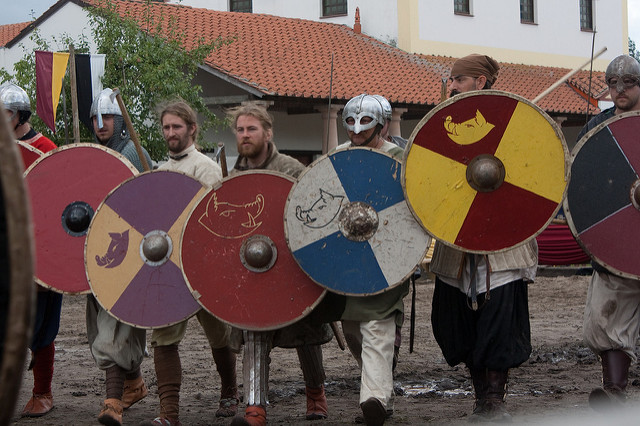
In The Vikings – A History Robert Ferguson suggests a different idea on the reasons for the start of the Viking Age, particularly in terms of the violence.
Chapter 3 on Causes of the Viking Age links together several things I’d not seen before.
One introductory comment points out that a Viking longship could be seen at a distance of about 18 nautical miles with good visibility. This is based on observations using modern reconstructions. If the sailors had a favorable wind, they could cover that distance in about an hour. If there were watchers on the shore there would be perhaps one hour notice before the arrival of a raid.
Author explains there were three major political powers that controlled Europe at the time. The Frankish Empire controlled most of Western Europe from what is today France to about the Oder river. The Byzantine Empire controlled what is currently Greece and Turkey. Several Muslim caliphates controlled Spain, Northern Africa, and what we call the Middle East.
Charlemange’s forced conversion of the Saxons
Starting in around 772, Charlemagne had as one of his main goals converting to Christianity the Saxons living on the northeast corner of his territory. The conversion was by force, of course, which is the way things were done in the middle ages.
In 772, his troops destroyed Irmensul, which was considered to be a sacred tree to the Saxons. That would have given great offense, obviously.
There were invasions of Saxon territory in 775, 779, and again in 782. After the 782 rebellion, Charlemagne carried out his massacre at Verden. He held 4,500 prisoners. He forcibly baptized them and then executed them.
The location for executing 4,500 Saxons was close to the Jutland Peninsula. On the border with Denmark, in other words.
Of note in this report is that the executed captives were not nobles, but just the run of average people.
There were forced relocations in 794, 797, and 798, with another insurrection defeated in 804.
The story of the forced conversions followed by executions of such a large group of people in 782 made its way into Denmark. Author suggests those reports probably created panic and fear across Denmark, perhaps into Norway and Sweden.
At this point consider that it is a very realistic possibility that a Scandinavian man must have realized that if he were captured by Franks there was a moderate to high probability of being the recipient of a forced baptism and then surrendering his head to the Christians.
Author suggests that violence between the Franks and Saxons is a possible explanation for the 789 incident at Portland, on the south coast of England. Some ships of Danes landed and were then met on the shore by the King’s representative, named Beaduheard, who demanding that the just-landed Vikings accompany him into town. The King’s man and his troops were killed. There were no reports of a plundering raid immediately thereafter.
Author suggests perhaps, just perhaps, the Danes were afraid they would be baptized by force and executed after the baptism. If they had that fear, being told to go into town by an official representative could easily cause a defensive fight to prevent their execution.
Match up the time of the mass slaughter in 782 with the 789 landing and a defensive fight to prevent their own death is a quite reasonable explanation for the fight in 789.
Author suggests the raid in 793 at Lindisfarne could be a result of the hostility between the Christian Carolingian Franks (or any Christians anywhere) and the heathen Scandinavians.
There are no definitive explanations for what kicked off the Viking Age. The author’s explanation of religious hostility is as good as any. Anger at the slaughter of 4,500 fellow heathens after their forced baptism could certainly lead to viciousness on a plundering raid.